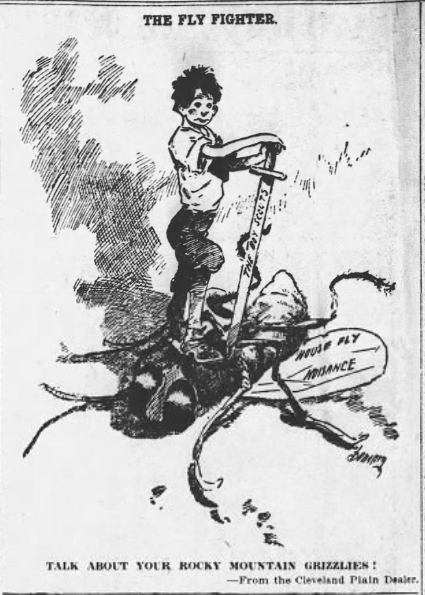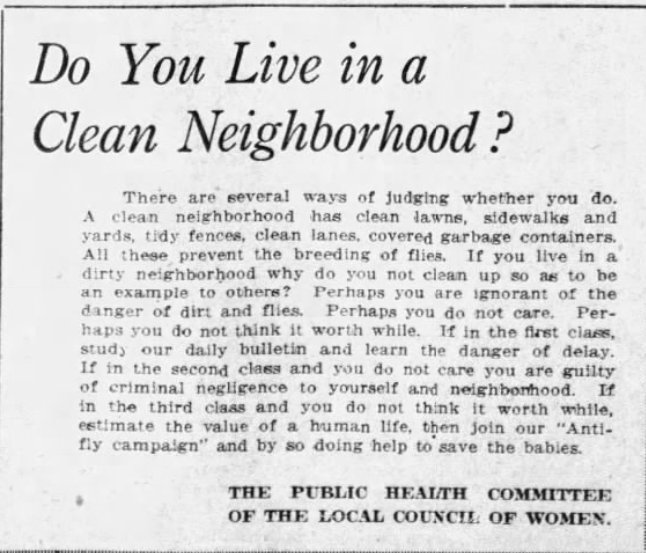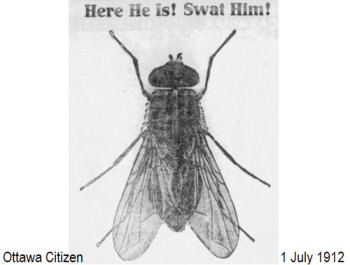1 July 1912
The best way of getting rid of Mr. Fly is to get rid of his boarding house and his breeding house—the rubbish heaps, the old barrel, the exposed manure pile, or whatever is usually found in a neglected city back yard. Ottawa Journal, 1913.
Musca domestica, the pesky housefly. Easily identified by the four black stripes on its thorax, the housefly, which measures about 5 to 7 millimetres, in length, can be found throughout the world wherever humans live. Indeed, the housefly has made a “career” of feasting on the detritus of humans and their domesticated animals. After mating, the female of the species lays her eggs in batches of 100 or more on rotting vegetable or animal matter, including carrion or feces. After a day or so, the larvae hatch and begin feeding. They mature in as little as two weeks depending on temperature conditions. A female housefly can live for about a month and can produce as many as 500 eggs during her lifetime. In the absence of avian and insectile predators, as well as humans armed with rolled up newspapers, two amorous flies can produce a gazillion descendants during a summer. Thankfully, this is not the case.
While houseflies play an important ecological role in recycling organic wastes, their habit of feasting on the garbage in the bin at the side of the house, or the dog poop in the backyard, before skittering over granny’s lemon chiffon cake is not an endearing feature. Consequently, they have long been considered a vector for the spread of disease. Their persistence and apparent clairvoyance are other annoying behavioural features. Who hasn’t futilely tried to discourage a determined fly from walking all over one’s arms or legs?
Sustained efforts to rid cities of the much-hated housefly took place during the early years of the twentieth century in major Eastern US cities, such as Cleveland, as well as in major cities in Canada, including Toronto, Montreal, Hamilton, and Ottawa. The objective was to curb the spread of disease, particularly tuberculosis, typhoid, and infant diarrhea, believed to be spread by houseflies.
Such efforts had many elements. First, cities introduced bylaws requiring their citizens to take steps to minimize the breeding grounds of flies by collecting and covering manure piles. Recall the prevalence of horses during this period; cars had yet to replace them to any significant degree. As one horse can produce ten kilograms of manure daily, equine waste disposal was a major problem. Much was simply left on the streets, thereby attracting flies. Second, public health organizations distributed literature to households on the habits of houseflies, their impact on public health, and how to kill them or, barring that, keeping food uncontaminated and homes pest-free. Third, children, often the Boy Scouts, were mobilized to kill the bugs and to spread the word; the rationale being to harness youthful zeal, and to educate the next generation who might be more open that their parents to new health ideas. Recall that the germ theory of disease was still relatively new during the early twentieth century. Many people still thought bad smells, called miasmas, were the cause of disease. The idea that flies could transmit disease by just walking on food was a novel concept for many.
In July 1912, the Montreal Daily Star hosted a “Swat the Fly” contest in Montreal, offering prizes totally an amazing $350—a huge sum at that time, equivalent to close to $10,000 today—with first prize being $25. The contest was open to all children, both boys and girls. The contest was a huge success. Nearly one thousand Montreal children answered the call, swatting approximately 25 million flies, and, more importantly, spreading the word about household hygiene. Their tally, which far exceeded the paltry tally of 1.5 million flies caught by Toronto kids, as well as those of cities south of the border, earned Montreal the title of “world fly-swatting champion.”
 Ottawa Evening Citizen, 15 June 1912Ottawa also took up the anti-fly challenge. In May 1911, city council passed a bylaw requiring downtown stables to contain manure in bins with tight covers or to be connected to the sewers. At the time, the Ottawa Citizen estimated that as many as three-quarters of downtown stables were not doing this. As well, the enforcement of existing hygiene laws appears to have been lax owing to the cost of regular inspections. The newspaper opined that “the greatest single step towards the elimination of the house fly in Ottawa will be when all stable within the city limits whether by careful inspection, or otherwise, are compelled to follow the simple and easily kept rules which other cities have imposed thereon.”
Ottawa Evening Citizen, 15 June 1912Ottawa also took up the anti-fly challenge. In May 1911, city council passed a bylaw requiring downtown stables to contain manure in bins with tight covers or to be connected to the sewers. At the time, the Ottawa Citizen estimated that as many as three-quarters of downtown stables were not doing this. As well, the enforcement of existing hygiene laws appears to have been lax owing to the cost of regular inspections. The newspaper opined that “the greatest single step towards the elimination of the house fly in Ottawa will be when all stable within the city limits whether by careful inspection, or otherwise, are compelled to follow the simple and easily kept rules which other cities have imposed thereon.”
In June 1912, it was announced in the Ottawa Citizen that there would be an anti-fly contest in the nation’s capital running for two weeks beginning Dominion Day. Ottawa’s new slogan for the period was “Banish the Fly!” The contest was organized by the Public Health Committee of Ottawa’s local Council of Women in co-operation with the city’s department of health. The Council provided nine prizes with a total value of $25, with the event open to both boys and girls under fifteen years of age. The boy or girl killing the most houseflies would win $10, with second place earning $5. There were also three third-place prizes of $2 each and four fourth-place prizes of $1. Captured flies were to be turned over to the office of Dr. Shirreff, the city’s chief medical officer, at City Hall, for inspection and counting. Children could use any sort of container in which to bring their “catch.” Any method of fly-catching was acceptable except apparently for the use of “tanglefoot paper.” The newspaper said that the competition was “a new and vital form of educating people to a danger long overlooked or neglected,” and hoped that the campaign would get a good response so that “Ottawa will this summer be a most unpopular resort for the fly.” A similar “Swat the Fly” contest was also launched in Hull.
Consistent with doctors’ recommendations, the newspaper advised kids to catch flies outside before they had a chance to come inside and spread disease. Homeowners were told to equip all windows and doors with screens to keep out the pest, and to move rubbish and refuse away from back doors. The Citizen also recommended poison as the most efficacious means of killing flies. Helpfully, the newspaper provided recipes. The first was an innocuous mixture of the yolk of one egg, 1/3 cup of sweet milk, one level tablespoon of sugar, and one level tablespoon of pepper. Alternatively, it recommended a mixture of two tablespoons of formalin and 16 ounces of equal parts of water and milk. Regardless of the mixture used, the Citizen said that it should be placed in shallow plates, with a piece of bread floating in the middle to allow more room for the flies to land on. As a testimonial to the effectiveness of the formalin trap, it cited a Professor R. J. Smith of North Carolina who apparently caught 40,000 flies in a calf barn during a 16-hour period using the recipe.
One thing the newspaper neglected to mention, however, was the dangers of formalin. A lethal dose for an adult human is about 30 millilitres, the amount recommended by the newspaper in its fly poison recipe. Used for embalming purposes and in dilute amounts as an anti-bactericide, formalin, a colourless liquid, releases formaldehyde gas which is both flammable and poisonous. Dangerous to have around the house, and not something one would want children to handle, woe betide any thirsty household pet that might be attracted to the milk and bread mixture.
Despite the exhortations of the Citizen, the “Banish the Fly” contest got off to a slow start. More than a week into the campaign, only nine boys and one girl had entered. The city kept a running tally of each participant’s “kill” and issued receipts. Half way in, John Cooney of 138 Besserer Street was in the lead with a total of 20,000 flies out of a total of 46,500 turned into City Hall.
In case you were wondering, health department clerks didn’t laboriously count each fly. Instead, the flies, which were brought into city hall in bottles, envelopes, matchboxes, and even a talcum power can, were weighed. Their weight in grammes was then multiplied by 200 to get an approximate number of houseflies.
 Public announcement, Public Health Committee of Ottawa’s Local Council of Women, Ottawa Citizen, 28 April 1915.Additional participants trickled in. By the close of the competition, twenty-two children—seventeen boys and five girls—brought a total of 458,300 flies to the Department of Health. In first place was eleven-year-old Roy Judd of 136 Besserer Street who had killed 61,700 flies. His preferred method was poison. In second place was Mortimer Thompson of 164 Hopewell Avenue. Ethel Moffat (age 12 years), of 143 Kent Street took the third position, and was the highest-scoring girl. John Cooney (age 10 years), who had been initially leading the competition came in fourth with 40,700 flies. John Cooney and Roy Judd, the ultimate winner, were next door neighbours. The youngest competitor was Clyde Swan of 201 Division Street (Bronson Avenue). The five-year old collected an impressive 7,600 flies.
Public announcement, Public Health Committee of Ottawa’s Local Council of Women, Ottawa Citizen, 28 April 1915.Additional participants trickled in. By the close of the competition, twenty-two children—seventeen boys and five girls—brought a total of 458,300 flies to the Department of Health. In first place was eleven-year-old Roy Judd of 136 Besserer Street who had killed 61,700 flies. His preferred method was poison. In second place was Mortimer Thompson of 164 Hopewell Avenue. Ethel Moffat (age 12 years), of 143 Kent Street took the third position, and was the highest-scoring girl. John Cooney (age 10 years), who had been initially leading the competition came in fourth with 40,700 flies. John Cooney and Roy Judd, the ultimate winner, were next door neighbours. The youngest competitor was Clyde Swan of 201 Division Street (Bronson Avenue). The five-year old collected an impressive 7,600 flies.
While anti-fly campaigns were launched in the years that followed, this was the only Banish the Fly contest held in Ottawa. Although the housefly population was barely dented, reviews were positive in that it helped to educate people about the relationship between public cleanliness and public health.
Whether the humble housefly deserved the opprobrium heaped upon it during the early twentieth century is less clear. According to Valarie Minell et al, the authors of Swatting Flies for Health: Children and Tuberculosis in Early Twentieth-Century Montreal, the housefly had been “vilified.” Indeed, today the house fly is generally viewed a nuisance rather than a major transmitter of disease. This probably reflects the fact that in urban areas there are now few horses and other forms of livestock, outhouses are a thing of the past, and kitchen waste is picked up weekly for composting. With fewer feeding grounds and hatcheries, housefly numbers are likely much smaller today than a hundred years ago. Nonetheless, Musca domestica is reportedly a carrier of hundreds of different forms of bacteria. Many of these bacteria are pathogenic to humans and can cause many diseases, including dysentery, tuberculosis, typhoid, and polio. To this long list, recent research has shown that the house fly can be a carrier of the bacteria H. pylori that can cause stomach ulcers.
So, the next time you spot a housefly, swat it.
Sources:
Khamesipour, F., Lankarani, K. B., Honarvar, B. & Kwenti, T. E., 2018. “A systemic review of human pathogens carried by the housefly (Musca domestica L.), BMC Public Health, Article No. 1049.
Minnell, Valerie. & Poutanen, Mary-Anne, “Swatting Flies for Health: Children and Tuberculosis in Early Twentieth-Century Montreal,” Urban History Review, Vol. 36, No.1 Fall 2007.
Ottawa Journal, 1911. “No Title,” 22 March.
——————-, 1911. “The Sanitary Inspection,” 12 June.
——————-, 1913. “One City Conquers Mr. Fly.
Ottawa Citizen, 1911. “Anti-Fly Bylaw,” 29 October.
——————, 1912. “Premium On Flies,” 7 June.
——————, 1912. “The Anti-Fly Campaign Gives Boys And Girls Chance To Earn Money,” 15 June.
——————, 1912. “Here He Is! Swat Him!” 1 July.
——————, 1912. “After Hull Flies,” 4 July.
——————, 1912. “Early Swatting,” 10 July.
——————, 1912. “An Educative Campaign,” 10 July.
——————, 1912. “Fly Campaign,” 11 July.
——————, 1912. “Fly Swatters Who Win Prizes,” 16 July.
Story written by James Powell, the author of the blog Today in Ottawa's History.
Retired from the Bank of Canada, James is the author or co-author of three books dealing with some aspect of Canadian history. These comprise: A History of the Canadian Dollar, 2005, Bank of Canada, The Bank of Canada of James Elliott Coyne: Challenges, Confrontation and Change,” 2009, Queen’s University Press, and with Jill Moxley, Faking It! A History of Counterfeiting in Canada, 2013, General Store Publishing House, Renfrew, Ontario. James is a Director of The Historical Society of Ottawa.






